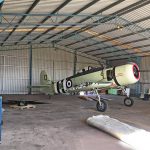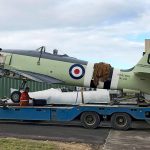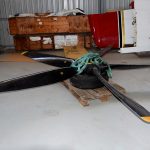
Our good friend John Parker at Warbirds Online recently visited Archerfield Airport near the city of Brisbane, Australia to see Hawker Fury FB.11 VH-SHF. A team from from Vintage Fighter Restorations was preparing the long-dormant fighter for the roughly 420 mile road journey south to their restoration shop in Scone. The former Iraqi Air Force Fury hasn’t flown in over a decade, but following her sale by government auction last October, she is finally on the way to regaining her flight status. John picks up the story from here…

The task of dismantling the aircraft was fairly straightforward. It took a minimum amount of work to reduce the aircraft into a manageable load for the road trip. The Sea Fury has folding outer wings, so these were removed and placed in a shipping container. The huge, five-bladed propeller was then removed to reduce the airframe’s overall height and it too was placed in a container. However, the engine, cowlings and empennage were left in situ. All of the vulnerable airframe openings, such as the cowling intake, were then sealed.
With the airframe now ready for transport, a large mobile crane hoisted the fuselage onto a low-ride, flatbed truck. The shipping container full of smaller components traveled on a separate truck for the 24-hour journey to Scone. Upon arrival in Scone the team from Vintage Fighter Restorations unloaded Fury and placed her in the co-located Pay’s Air Service Museum hangar where she awaits the commencement of her restoration.
Several important decisions have been made regarding the aircraft’s future. The fighter’s massive, 2,500 HP Bristol Centaurus Mk.18 18-cylinder, twin-row, radial engine will be retained, making it a rarity for modern Fury/Sea Fury rebuilds, which often swap out the original engine for the less-expensive-to-maintain Wright R-3350. However, although this Centaurus was in excellent operating condition when it was last flown, it will require a “bulk strip” to ascertain its condition and replace any worn components, or seals and hoses as required. But this is a normal procedure for an engine so long out of service.
In addition, the new owner has decided to repaint the aircraft in a new color scheme, although they haven’t yet disclosed whether they have any particular markings in mind. The current, rather faded and worn colors represent Royal Navy Sea Fury FB.11 WJ232 which Lieutenant Peter “Hoagy” Carmichael flew during the Korean War when he received credit for shooting down a North Korean MiG-15.
Work is set to commence on the restoration within a few weeks, and it will be great to see another example of the Hawker Fury/Sea Fury in Australian skies once more. The timeframe for this happy event, as always with such things, is dependent upon a number of unknowns at present, however given the aircraft’s excellent condition, the restoration team expects to have her back in the air well within 12 months.
Many thanks to John Parker for this latest report. Please be sure to check out his marvelous site HERE.
Richard Mallory Allnutt's aviation passion ignited at the 1974 Farnborough Airshow. Raised in 1970s Britain, he was immersed in WWII aviation lore. Moving to Washington DC, he frequented the Smithsonian’s National Air & Space Museum, meeting aviation legends.
After grad school, Richard worked for Lockheed-Martin but stayed devoted to aviation, volunteering at museums and honing his photography skills. In 2013, he became the founding editor of Warbirds News, now Vintage Aviation News. With around 800 articles written, he focuses on supporting grassroots aviation groups.
Richard values the connections made in the aviation community and is proud to help grow Vintage Aviation News.









Be the first to comment
Graphic Design, Branding and Aviation Art